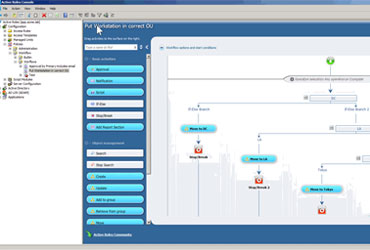Identity and access management (IAM) is about enabling secure, scalable and efficient operations across increasingly complex environments. The right IAM solution doesn’t just support IT, it actively reduces friction, tightens security and adapts to an organization’s environment. Better outcomes happen with solutions that align with organizational needs and don’t demand numerous workarounds.
Here are six key capabilities that can fundamentally change how organizations manage identity and access, reduce risk, and reclaim valuable time.
1. Delegation without native AD rights
Traditional delegation models often rely on assigning native Active Directory (AD) permissions, which can lead to over-privileged accounts and increased security risk. A more secure approach uses a proxy-based delegation model, where all actions are performed through a service account.
This means:
- Delegated permissions exist only within the IAM platform.
- Users can perform tasks like account creation or group management without having native AD rights.
- Users are blocked from bypassing controls or escalating privileges outside the system.
This model significantly reduces attack surfaces and ensures that permissions are tightly scoped and fully auditable.
2. Dynamic group membership based on real-time conditions
Groups are the foundation of access control in AD and cloud environments. Automating group membership based on user attributes, such as department, location or job title, ensures that access is always aligned with current roles.
For example, a rule might automatically add users to a group if their department is “Sales” and remove them if they transfer departments.
If the criteria of being in the Sales department is no longer met, then they are automatically taken out of the group, and the group is modified the user account and memberships as soon as the changes occur in AD.
These changes happen immediately, without waiting for external syncs or manual intervention.
Benefits include:
- Reduced risk of stale access
- Fewer manual updates
- Improved compliance and audit readiness
3. Multi-domain management without trusts
Especially after mergers or acquisitions, managing multiple domains can be both a logistical and security challenge. A flexible IAM solution allows administrators to manage multiple forests and domains without requiring domain trusts or complex configurations and without multiple domain charges.
This allows IT teams to:
- Apply consistent policies across environments
- Delegate access without modifying domain trust relationships
- Manage multiple domains and forests with existing permission templates and policies
4. Custom workflows and scripting for unique use cases
No two organizations are exactly alike. That’s why extensibility is critical. Even if 99% of IAM capabilities are available from a solution out-of-the-box, there are still instances when a business will ask for or require custom functionality. Support for custom scripting and using PowerShell, VBScript, JScript and others enables teams to build workflows that address niche or complex requirements.
One real-world example: A company needed to ensure that usernames were never reused, even decades later. By integrating a custom script with a SQL database, the provisioning process checked for historical usernames before creating new accounts.
This level of customization allows IT teams to:
- Automate unique business logic
- Enforce naming conventions and compliance rules
- Extend functionality beyond out-of-the-box features
5. Built-in change tracking and audit trails
Visibility into who did what and when is essential for both security and compliance. Built-in management history and reporting features ensure that every action taken within an IAM platform is logged and auditable.
This eliminates the need for third-party tools in many cases and provides:
- Immediate insight into changes
- Simplified audit preparation
- Greater accountability across teams
6. Operational efficiency and peace of mind
Perhaps the most transformative benefit is the operational efficiency gained through automation and control. By reducing manual tasks, minimizing human error and streamlining access management, IT teams can focus on strategic initiatives rather than repetitive admin work.
This doesn’t necessarily mean reducing headcount, it means unlocking capacity. Projects that have been delayed due to resource constraints, like server upgrades or cloud migrations, can finally move forward.
And with everything “on guardrails,” administrators further gain peace of mind knowing that:
- Access is granted and revoked automatically.
- Permissions are tightly scoped and monitored.
- The environment is secure, auditable and compliant.
Conclusion
Identity and access management is no longer just a backend function of IT teams. It’s a strategic security enabler. The features outlined here aren’t just technical enhancements – they’re business accelerators. They reduce risk, improve efficiency and give IT teams the tools they need to support growth and innovation.
Whether you're managing a single domain or a global enterprise, these capabilities can help you build a more secure, scalable and streamlined identity infrastructure.




